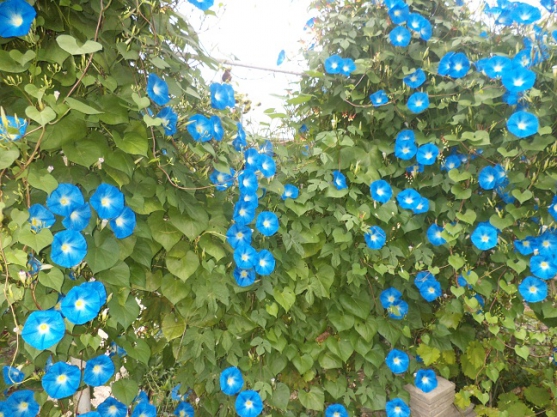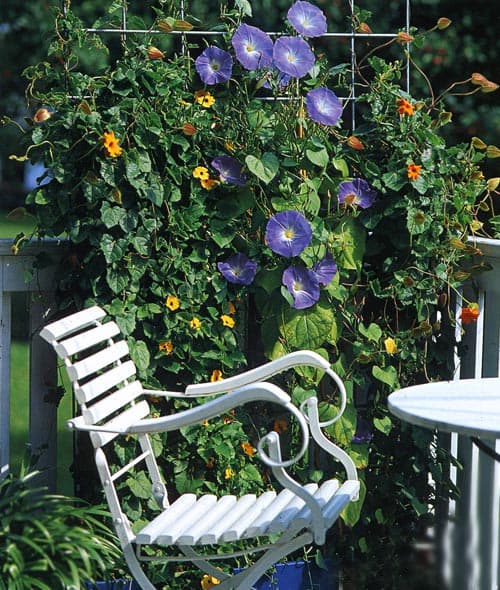This annual vine grows up to 2.5-3 m in length!
The flowers are large, 8-10 cm in diameter. It blooms profusely from June to October.
Agrotechnics.
The plant is light- and heat-loving, drought-resistant.
Propagated by sowing seeds in May to a permanent place, 2-3 seeds per hole or in peat pots in April (seeds must be soaked for 24 hours at room temperature).
1 gram contains about 50 seeds.

Morning-glory (Grannyvine) - Pharbitis rubro-caerulea = Ipomea rubro-caerulea = Ipomea tricolor.
Name: the genus received from the Greek words "ips" - a worm and "homoios" - similar, which is associated with the nature of the growth of underground rhizomes in perennial species of the genus.
The fruit is a capsule with 1-4 seeds. In 1 g up to 50 seeds.
Homeland - tropical America.
Perennial plant, cultivated as an annual, climbing, with branched stems reaching 4-5 m in height. The leaves are opposite, large, cordate or ovate-cordate, glabrous, wrinkled, on long petioles. The flowers are funnel-shaped, clustered 3-4 in bunches, sky-blue, with a white tube, 8-10 cm in diameter, purple-pink after flowering. Each flower blooms for one day. Flowers are open from morning until noon, in some varieties - until almost 5 pm. In cloudy weather, the flowers are open throughout the day.
The fruit is a cone-shaped capsule. Seeds are dark, elongated, slightly convex, viable for 2-4 years. In culture since 1830.
One of the most decorative curly annuals. Blooms profusely from July to October. Has garden forms and varieties with a striped corolla.
Location: photophilous and very thermophilic, they cannot stand even minor frosts (a site protected from winds is desirable).
Soil: they prefer loose, nutritious limed soil, on a well-fertilized soil they "fatten" to the detriment of flowering. These vines do not tolerate stagnant water.
Care: vines are grown with constant watering and top dressing with full mineral fertilizer with a low nitrogen content - its excess causes the growth of green mass to the detriment of flowering.
For all types of morning glory, supports of vertically stretched wires, fishing line, wire or mesh are needed, around which the stems will twine. And only the "Roman Candy" variety of Ipomoea is used as an ampelous plant for warm, sheltered places. With a sufficient amount of land in boxes, morning glories grow well on balconies and loggias with a south or southeast orientation.
Reproduction: sowing seeds in May in a permanent place, 2-3 seeds per hole or in peat-humus pots in March - April for seedlings. The optimum temperature for germination is 18 degrees. The seeds must be soaked for 24 hours. Those that are not swollen are pierced with a needle and soaked again. Seedlings appear in 6-14 days. Plant transplantation is poorly tolerated, therefore, when transferring seedlings into large pots (they do it twice), they must preserve a lump of earth with roots. A twig is inserted into each pot, along which the plant will curl, otherwise the stems will get confused and will break when trying to disassemble them. Seedlings must be planted with a lump of earth, keeping the distance between plants 15-20 cm. It can also be propagated by layering, cuttings, dividing rhizomes.

Janis Grau "Morning glories in blue".
Eating morning glory seeds (for psychonauts).
Before using the seeds of morning glory, it is imperative to rinse in hot water - this method allows you to remove some of the toxins from the surface of the seeds, so that less harm is done to the body, and the strength of unpleasant side effects will be significantly reduced.
Several "unconventional" ways of using the seeds of morning glory tricolor:
* The seeds can be simply eaten by grinding in a coffee grinder or mortar.
* You can create tea from morning glory seeds: for this, take 70 morning glory seeds (approximately: a teaspoon) and brew like regular tea.
* If you add about 30 seeds to your morning coffee, then the day will be pleasant and bright. Let us remind you that the seeds should be thoroughly rinsed with hot water before use!
Dosage.
One hundred morning glory seeds are enough for the first "trip". This is a small dose (however, don't rush).
It is necessary to identify the reaction of your body to the active substances of the morning glory.
After the first use, you should adhere to the following dosages:
- from 30 to 100 seeds for a slight change in consciousness and euphoria.
- 100 to 250 seeds for a full-fledged trip.
- from 250 to 500 seeds for a very strong trip (only for experienced!)
More than 500 seeds should not be consumed, since the body is saturated with morning glory alkaloids and there is no increase in the effects with an increase in the dose.
You should not use morning glory too often, as this practice leads to stress on the liver (it is advisable to take a course of drugs that improve liver function before using morning glory seeds).
Attention: morning glory is contraindicated in pregnant and lactating women, as well as people suffering from diseases of the liver, stomach or blood vessels, people with mental disorders.

Eng.: Heavenly-blue morning-glory, Grannyvine. Bot.: Ipomoea tricolor.
Usage: for vertical gardening.
Ipomoea is good for shading sunny terraces or verandas, wrap around a pergola, plant them along a mesh fence and close the area from prying, prying eyes.
You can simply plant the house on the south side, wrap around the southern windows, and the microclimate in the house will become more favorable - cool and humid, and the boards that surround the house outside will not dry out.
On a long-developed site, using a trellis with morning glory, you can separate a garden or vegetable garden, a household plot or a parking lot. And this will be the most beautiful fence. If you plant a gazebo with a table and benches with morning glories, you get a cozy place to relax.
Arches of bent metal rods over the path to the house, entwined with morning glory, will turn this path into a green corridor. It is even easier to build such an arch above the gate at the entrance to the site, to decorate the porch or balcony.
Ipomoea can also be planted in a flower garden. With their help, they break up the flat space of a large flower garden, which makes it more picturesque. Ipomoea can be used to create various green figures or a fountain with jets-stems flying in all directions or directed in one direction. And all that is needed for this is the support of the appropriate form and your imagination.
A very interesting option is to use green and dried trees as supports. Here endless possibilities for creativity open up, up to the creation of works of art. Branches of fruit or forest trees can be attached with wire to pipes driven into the ground, and then wrapped around them with morning glory.












